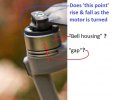I was inspecting all four motors closely today and noticed the bell housing on the rear starboard leg motor seems to have a wobble. It's not loose but when turning it slowly by hand, the gap distance between the bottom plate and the bell housing changes as the housing is turned.
I took all props off and ran the motors and could not feel any unusual vibrations. The shaft itself does not look like it rotates off axis either. Placing a thin rigid piece of plastic against the shaft while spinning doesn't reveal any strange vibrations either. The external temps of each motor as measured with an IR temp gauge all show within a few tenths of each other.
It's a little disconcerting to see the bell housing do that, but everything else about the motor looks fine. With the blades on and the motor turning, there are no extraneous vibrations and the blades track straight.
Unfortunately my dial indicator is broken so I can't measure runout of the shaft. Without that, the only thing I can think of at this point is that if the shaft isn't bent, the bell housing itself isn't true or isn't mounted well.
Can the housing be removed by unscrewing the two torx screws on the prop mount?
Should I be concerned?
I took all props off and ran the motors and could not feel any unusual vibrations. The shaft itself does not look like it rotates off axis either. Placing a thin rigid piece of plastic against the shaft while spinning doesn't reveal any strange vibrations either. The external temps of each motor as measured with an IR temp gauge all show within a few tenths of each other.
It's a little disconcerting to see the bell housing do that, but everything else about the motor looks fine. With the blades on and the motor turning, there are no extraneous vibrations and the blades track straight.
Unfortunately my dial indicator is broken so I can't measure runout of the shaft. Without that, the only thing I can think of at this point is that if the shaft isn't bent, the bell housing itself isn't true or isn't mounted well.
Can the housing be removed by unscrewing the two torx screws on the prop mount?
Should I be concerned?











